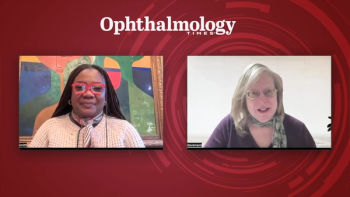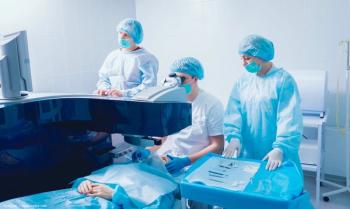
- Ophthalmology Times: July/August 2025
- Volume 50
- Issue 4
Next-generation IOLs advance complex cataract care
Key Takeaways
- Cataract surgery post-refractive procedures requires precise IOL power calculation and addresses variable epithelial healing challenges.
- Generation X patients often seek spectacle independence, complicating cataract surgery due to their history with refractive surgeries.
Surgeons navigate unpredictable healing and anatomy with customized strategies.
Cataract surgery in patients who have previously undergone refractive procedures, such as LASIK or radial keratotomy (RK), presents unique challenges, noted Steven J. Dell, MD, medical director of Dell Laser Consultants in Austin, Texas, during an Ophthalmology Times Case-Based Roundtable. These challenges include precise IOL power calculation, variable epithelial healing, and specialized solutions such as piggyback lenses and customized lens selection to meet high expectations for spectacle independence.
Surgeons are seeing many Generation X patients seeking refractive lens exchange or cataract surgery. Patients in this demographic grew up wearing soft contact lenses, and many underwent RK or laser vision correction (LVC). They desire spectacle independence, Dell said.
The ability to calculate IOL power is improving. “However, one of the most challenging areas for IOL calculations is in the post-LVC cohort, because we know that residual refractive error is a major cause of dissatisfaction after IOL implantation,” he said.
The weak link in the process is determining the corneal power, Dell added. Although patients who underwent RK were happy with the result, clinicians must determine both the level of astigmatism and the IOL that is compatible with the cornea.
Enhancement procedures can be challenging for patients who have previously undergone a LASIK procedure, a refractive lens exchange, or cataract surgery. Options such as lifting flaps or creating new smaller or larger side cuts are often considered unattractive. Photorefractive keratectomy has been an option in these cases, but Dell described that as “tricky” because of epithelial irregularity or unpredictability.
The challenging epithelium
The epithelium in these patients varies widely, Dell explained. “The thickness might be…
30 µm or 80 µm depending on where the cornea was measured,” he said.
If the epithelium is removed, this can create a lensing effect of the epithelium itself. After removal, it could regrow in a manner that is different from the original presentation. This can occur after LVC for hyperopia.
Another scenario is that the central cornea may be thicker, forming a positive meniscus lens after LVC for myopia.
Healing is extraordinarily unpredictable. For example, a patient with LVC may have an epithelium that is now 75-µm thick but initially was 50-µm thick. This patient will be hyperopic because the epithelium does not have the same refractive power as an 80-µm epithelium, but it may grow back very slowly to 75 µm or 80 µm after 1 or 2 years.
“If patients are already unhappy and need an enhancement after IOL implantation, they shouldn’t be told to wait [1.5 years] and then things will work out,” Dell said.
This is a common scenario after IOL implantation, and surgeons should have a plan, which may include an IOL exchange or implantation of the Light Adjustable Lens (LAL; RxSight).
A representative case
A 72-year-old man underwent a 16-incision RK more than 20 years ago. The patient was extremely satisfied with the refractive surgery despite a refraction of +8.0 D and 5.0 D of astigmatism in the right eye.
Dell observed an important disparity in the right eye between the patient’s cataract, which was about 20/25, and his visual acuity, which was 20/50. The eye has irregular astigmatism with a zone of corneal power over 36 D, adjacent to a zone with 28 D, a significant disparity in the pupillary center. This difference translates to a 2- to 3-line disparity between the refraction and the cataract. Importantly, this improved with pinhole testing in this eye.
Dell suggested an IC-8 Apthera IOL (Bausch Surgical) as a logical choice. However, the patient needed an IOL of 35 D or 36 D, and the highest lens power available was only 30 D. An Apthera IOL was implanted in the bag using a scleral tunnel incision because of the 16-incision RK. With only the IOL, the refraction would have been +4 to +6 D. He then implanted an LAL (as a primary piggyback IOL) in the sulcus in front of the Apthera IOL. This is an off-label use of IOL and is not commonly performed, he explained.
Before the LAL adjustment at about 6 weeks postoperatively, the refraction was +1.75-4. Ultimately, the visual acuity was 20/25-2 with a small refractive error. “This was a tremendous result,” Dell said.
Cases of late LVC enhancements are complicated, Dell pointed out, but they are becoming increasingly important. “PRK is probably the best option after LVC, but it’s imperfect. The IOL designs have made precision really critical in this highly demanding population,” he said.
References
Bausch + Lomb announces voluntary recall of enVista Aspire, enVista Envy and certain enVista monofocal intraocular lenses. News release. Bausch + Lomb. March 27, 2025. Accessed July 10, 2025.
https://ir.bausch.com/press-releases/bausch-lomb-announces-voluntary-recall-envista-aspiretm-envista-envytm-and-certain Bausch + Lomb returning enVista intraocular lenses to market following voluntary recall. News release. Bausch + Lomb. April 24, 2025. Accessed July 10, 2025.
https://ir.bausch.com/press-releases/bausch-lomb-returning-envistar-intraocular-lenses-market-following-voluntary-recall
Articles in this issue
4 months ago
The future of imaging is out of this worldNewsletter
Don’t miss out—get Ophthalmology Times updates on the latest clinical advancements and expert interviews, straight to your inbox.













































